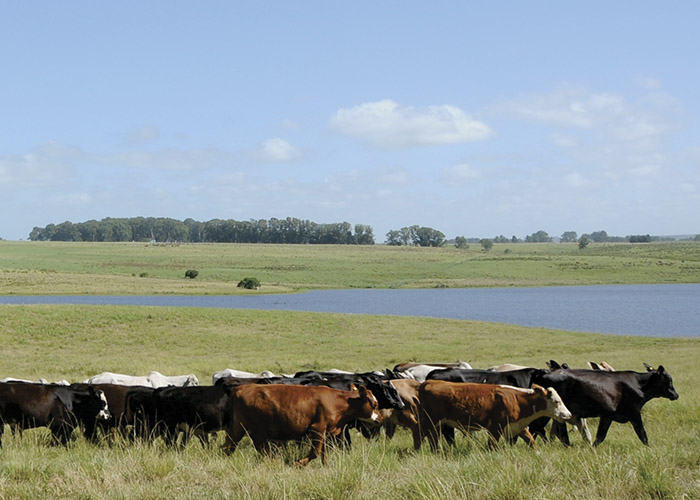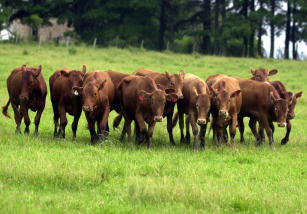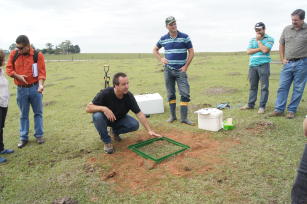Animals raised freely in the Pampas supply healthier meat
Animals raised freely in the Pampas supply healthier meat
Free-range beef from the Pampas is healthier from a nutritional point of view. Besides the important supply of nutrients such as iron and B-complex vitamins, the animal protein offers greater Omega-3 content when compared with cattle raised in confinement. The research findings that prove that were parameterized by the Laboratory of Beef Science and Technology at Embrapa Southern Livestock, led by the researcher Élen Nalério, and shows that the meat produced in the natural grasslands of the Pampas biome has fat profiles that are beneficial to consumers.
“In the Pampas, the animals' diet is mostly composed of the rich variety of natural pastures, which originate a product with a healthier fat profile, since it has more Omega 3 than Omega 6”, the scientist explains.
Such Omega 6 to Omega 3 ratio is balanced when it is at levels by 4:1. Nevertheless, the diets of Western populations characteristically have Omega 6 to Omega 3 ratios reaching 15:1, which represents potential risk of heart, autoimmune and other inflammatory diseases. That is mostly due to humans' increased carbohydrate consumption, especially from cereals.
“The same occurs with ruminants. When they are fed with forage-based diets, they supply beef with higher content of the Omega 3 type of fatty acids. Meanwhile, animals that are finished with more intensive diets that are high in grain content yield meats with greater Omega 6 content. It is important to emphasize that before the advent of modern agriculture, human diets were composed of a perfect Omega 6 to Omega 3 ratio, of 1:1”, Nalério stresses.
Healthy fatOmega 3 is a type of polyunsaturated fat that is essential to human health, which is not produced by the body and thus has that to be obtained from foods or specific supplements. Some fish, vegetables and fruits are already known sources of this substance. |
Different products
It is in the fields that it all happens, with animal feed playing a determining role in this process. “The animal breeding and finishing system directly interferes with meat characteristics. On one end, extensive production exclusively with pastures, and on the other end, full confinement with grain feed, completely different products are established”, the researcher asserts.
This difference is not only in the type of fat that is formed. “Bovines are animals that are naturally ready to digest fibers from grass. In order to digest grains, they need to adapt. Such variation in their feed makes totally different fats be formed, and this also interferes with the product's flavor and aroma”, the researcher underscores.
While the meat produced in the fields has a lively color and more yellowish fat, confined cattle beef is paler and has whiter fat. “The grass has carotenoids, which give the fat a yellow color. Meanwhile the color of the meat is influenced by the lower or higher presence of myoglobins. In pastures, the animal walks more and needs to oxigen the muscles, which increases myoglobin content and originates a more intense red color in the meat”, the scientist explains.
Chance of differentiation in the market
The researcher stresses that we cannot ascertain that the meat produced in the Pampas is better, once this kind of assessment involves several subjective factors. “However, we can guarantee that it is differentiated for many reasons. One of them it is that cattle that graze in native grasslands can form a type of fat with better nutritional quality, which is a trait that has awakened large public interest”, the scientist reports. “The beef's lipid profile is provenly healthier. This is an important differential that can and should must be treated as an opportunity for added value in the market”, she recommends.
As the head of Technology Transfer of Embrapa Southern Livestock, Estefanía Damboriarena, several initiatives to add value to the beef through differentiation with the use of collective trademarks are already in progress. There is the example of Alianza del Pastizal, which places products with their trademark in a large network of supermarkets; Apropampa, which is in a negotiation stage to place products with a collective trademark in the market; in addition to the initiatives by Breeders' Associations, such as the Brazilian Association of Hereford and Braford Breeders and the Brazilian Association of Angus Breeders,” she states.
Historical relationship between cattle farming and the Pampas
Intensely debated in present times, the kind of animal production has increasingly interfered with consumers' decision at the time of the purchase. Studies have already shown that customers are willing to pay more for healthier, more nutritional products that are sustainably produced, despite being unused to their flavor.
“There is a strong concept of meat production in the Pampas region: the animal roams freely, and the presence of the cattle in these fields has helped to preserve the biome, its fauna and flora, on top of being part of the history and culture of its people. The biome is adapted to cattle farming: it is conserved by producing in it”, the Embrapa researcher asserts.
Well-managed pasture accumulates carbon
Frequently associated with greenhouse gas emissions effect (GHG), cattle farming practised in the Pampas has shown the other side of the coin. Embrapa research shows that there is a positive and sustainable balance between GHG emissions from the animals and the carbon fixed by the plant roots. “Our research has proven that the animals finished in well-managed natural pastures not only give off less methane, but are also in a system that accumulates quite a lot of carbon, thus providing an important ecosystem service”, explains the Embrapa researcher Cristina Genro.
For a year, scientists measured methane emissions from Hereford steers submitted to different levels of intensification in natural Pampa pastures. The animals remained in native grassland with a stocking rate adjusted to 12% LW (12 kilos of dry grass per 100 kilos of animal live weight), with three levels of intensity of use: natural grassland, fertilized natural grassland and natural fertilized grassland overdown with ryegrass and red clover. The last one recorded lower methane emissions per animal, 31.6 kg/year. Meanwhile in fertilized natural grasslands, emissions totalled 42.8 kg/year, and in natural grasslands, 46.35 kg/year.
“It is important to underscore that the Intergovernmental Panel on Climate Change (IPCC) estimates methane emissions at 56 kg/year per animal in this same category in Brazil. That is, the results show that methane emissions per animal in the Pampas biome are far below the estimate by IPCC”, affirms Cristina, coordinator of the Pecus Project in the Pampas biome (see box below). According to the scientist, if this difference is multiplied by millions of cattle head raised in the Pampas, the amount of methane produced by the animals would be extremely lower than the one established by the international organism..
More than two centuries of extensive cattle farmingThe Pampas biome is basically formed by natural grasslands with rich biodiversity of plant and animal species. It is in this context that cattle farming has been practiced for over two centuries, an economic activity that sustainably uses natural resources and contributes to maintaining the ecosystem. Studies point the to existence of about 450 grass species and 150 leguminous plants, many of whici with enormous forage potential. Research conducted at Embrapa Southern Livestock shows that the sustainable exploration of this grassland environment can be a very successful strategy for cattle production in the region. For the Embrapa researcher José PedroTrindade, the management of native grasslands is the secret for the development of profitable cattle farming with quality that conserves the environment. That is, the interaction between the farmer and the environment is essential for the success of the activity. “We are proposing farmers have a new outlook with relation to native grasslands. A recognition of the wealth of natural resources in South Brazilian fields and their potential, which can result in durable, quality production processes”, he highlights. The conservation of the grasslands is also responsible for a series of environmental services. According to the Embrapa researcher Leandro Volk, one these services is the wealth of species in the fields, which provides conservation and the maintenance of soil life when it is well-managed. “The diversity of species' root types and form, even those withou forage value, provides greater infiltration and water storage in the soil, among others services”, he concludes. |
Translation: Mariana Medeiros
Felipe Rosa (14406/RS)
Embrapa Southern Livestock
Press inquiries
pecuaria-sul.imprensa@embrapa.br
Phone number: +55 53 3240 4650
Further information on the topic
Citizen Attention Service (SAC)
www.embrapa.br/contact-us/sac/




